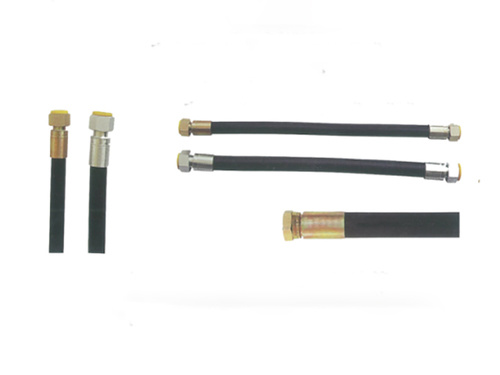ProductsDetails

High-pressure Hydraulic Hose Connecting Hydraulic Station and Cylinder
I. Product Overview
The high-pressure oil pipe connecting the hydraulic station and the oil cylinder is a key component for power transmission in the hydraulic system. It shoulders the important mission of conveying the high-pressure hydraulic oil output by the hydraulic station to the oil cylinder, thereby driving the oil cylinder to complete various actions. For example, in a filter press, it pushes the filter plates to be tightened and loosened, and in construction machinery, it enables the components to extend, retract, and rotate, etc.
II. Product Structure and Materials
Structure: The high-pressure oil pipe is usually composed of an inner rubber layer, a reinforcement layer, and an outer rubber layer. The inner rubber layer is in direct contact with the hydraulic oil, playing a role in sealing and preventing the hydraulic oil from eroding. The reinforcement layer is woven or wound with multiple layers of steel wires, endowing the oil pipe with strong pressure resistance. The outer rubber layer mainly serves as a protective function, preventing the oil pipe from external wear, corrosion, and mechanical damage.
Materials: The inner rubber layer generally uses oil-resistant rubber materials such as nitrile rubber, which has good oil resistance and sealing performance. The steel wires in the reinforcement layer are made of high-strength alloy steel to ensure that the oil pipe can withstand high pressure. The outer rubber layer mostly selects rubber materials such as neoprene, which has excellent wear resistance, weather resistance, and corrosion resistance.
III. Product Features
High Pressure Resistance: It can withstand extremely high working pressures, meeting the high-pressure requirements of different hydraulic systems and ensuring the stable transmission of hydraulic oil. The common working pressure range varies from dozens of megapascals to hundreds of megapascals.
Corrosion Resistance: The oil-resistant and corrosion-resistant materials of the inner and outer rubber layers enable it to adapt to various hydraulic oils and harsh working environments, extending the service life of the oil pipe.
Good Flexibility: Despite bearing high pressure, the oil pipe still has good flexibility, making it easy to install and arrange. It can move flexibly in complex mechanical structures, reducing the stress concentration caused by bending.
Strong Sealing Performance: Advanced manufacturing processes and high-quality sealing materials ensure that there is no leakage in the oil pipe under high pressure, effectively avoiding the waste of hydraulic oil and environmental pollution. At the same time, it improves the working efficiency and safety of the hydraulic system.
Aging Resistance: The weather-resistant materials of the outer rubber layer enable it to resist the erosion of factors such as ultraviolet rays and ozone, and it is not easy to age and crack, ensuring the stable performance of the oil pipe during long-term use.
IV. Product Specifications and Application Scope
Specifications: The oil pipe has a variety of inner diameter specifications, ranging from a few millimeters to dozens of millimeters, which can be selected according to the flow requirements of the hydraulic system. The working pressure range is wide, covering low-pressure, medium-pressure, and high-pressure systems. The length can be customized according to the actual installation requirements to meet the connection needs of different equipment.
Application Scope: It is widely used in various hydraulic equipment, such as filter presses, construction machinery (excavators, loaders, cranes, etc.), mining machinery, metallurgical equipment, petrochemical equipment, and industrial automation production lines and other fields.
V. Product Installation and Maintenance
Installation: During installation, ensure that the connection parts of the oil pipe are clean and free of impurities. Use appropriate connectors and sealing parts for connection and tighten them according to the specified torque to prevent leakage. The arrangement of the oil pipe should avoid excessive bending and twisting, and maintain a certain degree of looseness to reduce stress.
Maintenance: Regularly inspect the appearance of the oil pipe to check for any abnormal phenomena such as wear, cracks, and bulges. Check the sealing performance of the connection parts, and replace the sealing parts in a timely manner if there is leakage. According to the usage situation of the hydraulic oil, replace the hydraulic oil regularly to prevent impurities from damaging the oil pipe.
VI. Product Advantages
Compared with other similar products, our high-pressure oil pipes adopt more advanced production processes and high-quality raw materials, with higher quality and reliability. The strict quality inspection process ensures that each oil pipe meets high standards, providing customers with stable and efficient hydraulic transmission solutions, reducing the risk of equipment failure, improving production efficiency, and being an ideal choice for the connection of your hydraulic system.
 Recommended News
Recommended News
-
Master These Tips, Easily Solve Common Faults of Diaphragm Filter Press Plates
2025-04-28 12:03:11
-
Unveiling Methods to Prolong the Service Life of Diaphragm Filter Press Filter Plates
2025-04-26 09:51:45
-
Key Points of Routine Maintenance for Diaphragm Filter Press Filter Plates
2025-04-25 05:13:34
-
What Are the Advantages of Highly Elastic Diaphragm Filter Plates in Filter Presses?
2025-04-24 03:04:12
-
Do you know about the diaphragm filter plate of a filter press with high-efficiency filtration capabi
2025-04-23 12:18:11
 Contact us
Contact us
—— Contact:Manager
—— Tel:+86 16632826789
—— Email:sales@hbscfilterpress.com
—— Url:http://www.hbscfilterpress.com
—— Address:West Zone of Economic Development Zone, Fucheng County, Hengshui City, Hebei Province









